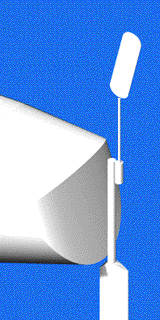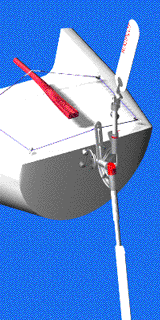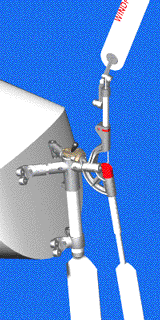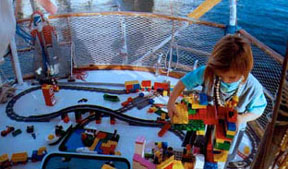|
This section of our site looks at some of the key criteria you might like to bear in mind when looking for the right self-steering system. Windvane steering systems have been gradually evolving for more than thirty years. The twelve basic designs that have emerged over this period are illustrated below. The twelve types of system |
||||||||||||||
 |
 |
 |
 |
|||||||||||
| 1 Windvane only V-vane | 2 Windvane only H-vane | 3 Auxiliary rudder V-vane | 4 Auxiliary rudder H-vane | |||||||||||
 |
 |
 |
 |
|||||||||||
| 5 Trim tab on auxiliary rudder V-vane | 6 Trim tab on auxiliary rudder H-vane | 7 Trim tab on main rudder V-vane | 8 Trim tab on main rudder H-vane | |||||||||||
 |
 |
 |
 |
|||||||||||
| 9 Pendulum trim tab V-vane |
10 Servo-pendulum V-vane |
11 Servo-pendulum H-vane |
12 Double rudder H-vane |
|||||||||||
|
Each system has its own inherent advantages and disadvantages. Where the balance is favourable, designs have prospered, but in some cases the scales are too heavily loaded the other way. Trim-tab systems and V vanes, for example, both appear to have had their day and you are unlikely to encounter either. Three system types now dominate the market: |
||||||||||||||
 |
||||||||||||||
Auxiliary rudder systems (types 3, 4, 5 and 6)How they work:
An auxiliary rudder system generates no servo power and is consequently limited in terms of the size of vessel and weather conditions it can cope with reliably. This limit in practice depends on the design, main rudder position and lateral surface area and usually lies somewhere between 37 and 40 ft. Effective steering in all likely conditions is only possible if the auxiliary rudder can generate sufficient force to turn the rudder; an underpowered system cannot be regarded as a satisfactory self-steering solution. Bear in mind too that the steering force available is solely a function of the apparent wind speed and that the apparent wind speed is relatively low on the downwind courses favoured for passage making. |
||||||||||||||
Servo-pendulum systems (types 9, 10 and 11)How they work:
The enormous mechanical advantage generated by the servo system makes servo-pendulum vanegears powerful enough to steer a yacht of up to 60ft and 30 tonnes effectively. The pendulum arm and, in consequence, the transmission lines, generally only have about 25 cm or 10 in of travel. The critical factor determining the steering performance of a servo-pendulum system is the quality of the line transmission. The shorter the lines and the smaller the number of turning blocks used to link the windvane gear to the tiller or wheel, the larger the steering movements and the better the steering quality will be. Poor force transmission with slack, stretchy or stiff lines and too many turning blocks means most of the available travel will be wasted and the windvane gear will accordingly only be able to move the main rudder by a few degrees. |
 |
|||||||||||||
Double rudder systems (type 12)Windpilot has combined the advantages of the two systems described above by coupling its conventional servo-pendulum unit (the Windpilot Pacific) to a dedicated auxiliary rudder. The resulting double rudder system, the Windpilot Pacific Plus, operates independently of the main rudder like an auxiliary rudder system, but also benefits from the vastly greater steering force delivered by the servo-pendulum mechanism. Conditions that would overload a servo-pendulum only system with its limited steering angles are all part of a day's work for the double rudder, because:
The number of sailors taking on the challenge of long-distance passage making has increased markedly over the past twenty years. While small crews are still the norm, the boats they choose to sail are considerably larger than was once the case and more and more of them feature a centre cockpit. Longer voyages, small crews, bigger boats and centre cockpits: all four factors increase the demands placed on windvane steering systems and all four have helped to drive the ongoing development of the Windpilot range. We believe the Pacific family represents the logical next step in the evolution of windvane steering.
|
||||||||||||||
 |
||||||||||||||
Reserve steering force for servo-pendulum and double rudder gearsSteering with the wind and good sail trim are the keys to minimal rudder action and fast sailing. Large steering movements and excess weather helm add up to sailing with the brakes on Sometimes, however, big and vigorous steering corrections are essential.If the windvane steering system does not have sufficient force in reserve to make big corrections in a sudden gust, for example, the boat will round up and stall. Forget about a good night's sleep! A windvane system constantly working close to its limits will have to be nursed through more active weather by reducing sail area. "Reef down prematurely, but that's slow!" - Exactly! Only a system with plenty of power in reserve can be relied upon to provide effective steering across the full range of conditions. Self-steering underpowered? Rudder movements inadequate? Effective rudder angle too small? Then the only answer is to steer by hand, which is anything but enjoyable with the rain lashing down in the black of night days from anywhere. A servo-pendulum system steering via transmission lines moves the main rudder by no more than a few degrees. Steering quality is also affected by
A double rudder system, in contrast, can put the helm over 25 degrees. Double rudders are enormously efficient, as
|
||||||||||||||
 |
||||||||||||||
 |
||||||||||||||
System matchingA servo-pendulum system will almost never be a perfect match for the main rudder through which it has to steer. Transmission line routings, wheel diameter and number of revolutions lock to lock all vary, as do main rudder design and profile. A double rudder system, on the other hand, is a perfectly balanced unit, a closed system with no variable components.A double rudder will still have plenty in reserve long after conditions would have overwhelmed a servo-pendulum system. The longer your trip, the smaller your crew is likely to be and the greater the need for a quiet and totally reliable accomplice at the reins whatever the conditions. One more time: steering by hand might be fun around the buoys, but it soon turns into torture on a long passage!
|
||||||||||||||
Which system suits which type of sailing?Holidays and weekends The Pacific at its best:
Bluewater sailing The Pacific Plus at its best:
If it comes down to a decision between the Pacific and Pacific Plus, a simple price comparison might be the answer. The Pacific Plus is more expensive than the Pacific even including transmission lines, wheel adaptor and so on. How big is the price gap? Not big enough to stop countless happy Pacific Plus owners forgetting all about it after the first few night watches at sea! A strong self-steering system with power to spare represents peace of mind, but peaceful sailing, restful off-watches and good sleep are only half the story: on a long voyage a system that saves its best for when the weather turns nasty will sooner or later be the difference between a good yarn and a painful trip to hospital and/or the boatyard. |
Which system for your boat?PACIFIC LIGHT
The PACIFIC is intended for
The PACIFIC PLUS is designed for
|
|||||||||||||
 |
||||||||||||||
WINDPILOT - because you have better things to do with your time! |
||||||||||||||
